The Prowlers, Squads and Boxes That Cops Have Loved
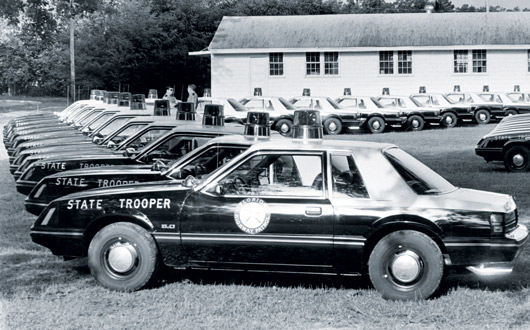
Cop cars are high performance at a low price. They have to be big enough to carry police gear and transport prisoners, but nimble enough to hang with Porsches in the corners. They need to be robust enough to withstand rolling over curbs, pushing aside stalled cars, grinding through gullies and bouncing over medians, but comfortable enough for officers to get through each shift with their backs intact. And they have to do it for a low price because government agencies are buying them.
The 10 greatest of the species are worth celebrating. So here we are, celebrating.
Throw some stickers on practically any car and it can be used as a police vehicle. But since the mid-1950s, manufacturers have been building specific models only for law enforcement duty. To keep prices down, they’re all based on regular production sedans or coupes, but each has been fortified to withstand the brutal life of every day on patrol. It’s the classic line from 1980’s “The Blues Brothers”: “It’s got a cop motor — a 440-cubic-inch plant. It’s got cop tires, cop suspension, cop shocks. It’s a model built before catalytic converters, so it’ll run good on regular gas. What do you say? Is it the new Bluesmobile or what?” (Incidentally, though the Bluesmobile was a 1974 Dodge Monaco, that model didn’t make this list.)
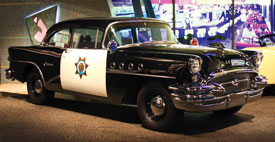 1955 Buick Century 68
1955 Buick Century 68
In the early 1950s the California Highway Patrol was looking for a vehicle that could keep up with the state’s burgeoning population of hot rods and sports cars. The result of that quest was one of the first cars built specifically for police use, the Buick Century 68.
Buick built 270 of these two-door sedans, 135 with manual transmissions and 135 with automatics. The body itself was the relatively lightweight Special, the cheapest car in the Buick line. The engine, however, was the 322-cubic inch V8 from the more upscale Century model rated at 236 horsepower. And the oversize drum brakes came from the flagship Roadmaster.
“During dynamometer tests,” reported the April 1955 issue of Highway Patrolman magazine about the Century 68, “the car developed 148-horsepower at the rear wheels and reached a wheel speed of 108 mph against the four-horsepower drag of the machine. At this point the test was terminated abruptly when the rubber tread spun off the tire of one of the rear wheels that was being tested.”
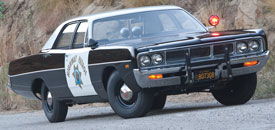 1969 Dodge Polara 440
1969 Dodge Polara 440
When old-timers get together and talk squad cars, this is the one that gets reverence. The full-size 1969 Dodge Polara police special was relatively lightweight thanks to its unibody construction and definitely overpowered due to the 375-horsepower, 440-cubic-inch V8 under its hood.
Channeling all that power through a three-speed TorqueFlite automatic transmission, in testing conducted by the Michigan State Police, the ’69 Polara swept to 60 mph in only 6.3 seconds and blitzed through the quarter-mile in 14.4 seconds at 98 mph. And it sped around the big oval at the Chrysler Proving Grounds in Chelsea, Michigan, at an unheard of 147 mph. Even by 21st century standards, that’s astoundingly fast.
To many officers who drove one, the ’69 Polara will always be the greatest cop car of all time.
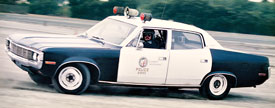 1972-1974 AMC Matador Enforcer
1972-1974 AMC Matador Enforcer
AMC seemed to always be on the verge of oblivion. That didn’t keep it from trying to raise its own profile with a police version of its mid-size Matador sedan.
The 1972 Matador woke up with AMC’s largest 255-horsepower, 401-cubic inch V8. It became an iconic police car of the 1970s. “At that time American Motors didn’t have that great a reputation, but the Matador was an extremely good police car,” said veteran Los Angeles Police Department driving instructor Jerry Bush to Hemmings Muscle Machines in 2005. “It was fast, it had superior brakes to the Plymouths, and it handled pretty well. … We convinced Motor Transport Division that it would be best to train officers in the cars they’re going to be driving on the street and not in the older cars. They agreed — and gave us a fleet of 18 new Matadors.”
As Matadors were retired from the LAPD fleet, they often wound up in movies and TV shows. It’s hard to get through an old episode of “The A-Team” or “The Rockford Files” without seeing one destroyed.
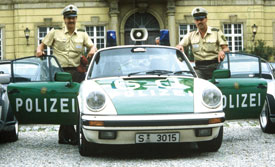 1965-1997 Porsche 911
1965-1997 Porsche 911
Every law enforcement agency has its own particular challenges. For the German police who patrol the famed Autobahn, that challenge is keeping up with traffic flow on roads that often have no speed limits at all. The solution is the Porsche 911.
The 911 has never been an inexpensive car, but for the specialized duty along the Autobahn it’s a logical patrol vehicle. Particularly during the 1960s, when the 911 itself was still new, the Polizei Porsches became iconic in their cream and green livery. However it wasn’t just the Germans who chose the 911 as their highway prowler. The Dutch highway patrol has also used 911s, painting its cars orange and white.
As more conventional sedans have grown more capable and powerful, the need for 911 police vehicles on the Autobahn has diminished. But as late as the 1990s Porsche was still providing cars for this duty. And one of these later cars is on display at the Porsche Museum in Stuttgart, Germany.
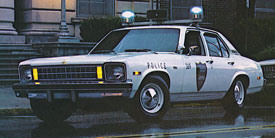 1975-1979 Chevrolet
1975-1979 Chevrolet
Nova 9C1
The fuel crises of the mid-Seventies led many police agencies to seek a car that would be more fuel efficient than the full-size sedans with the big-block engines most were using then. It was the brainstorm of Motor Trend magazine’s then-Executive Editor John Christy to build a smaller police car using the body of the compact Chevrolet Nova sedan and many of the high-performance parts from its brother, the Camaro Z/28 performance car.
Through his Motor Trend job, Christy had contacts within General Motors, and since he was a reserve deputy with the Los Angeles County Sheriff’s Department (LASD) he knew what law enforcement wanted in a car. He put them together and in 1975 the Nova 9C1 police vehicle was in production powered by a 350-cubic-inch small-block V8 making 170-horsepower.
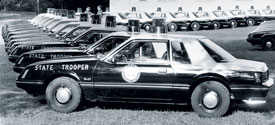 1982-1993 Ford Mustang
1982-1993 Ford Mustang
Special Service Package
By the early 1980s, police cars had slowed down under the pressure of emissions laws and fuel economy concerns. Most disastrous of all was the 1980 Dodge St. Regis supplied to the California Highway Patrol. Powered by a 318-cubic inch V8, that car was so slow that the agency feared it stood no chance of keeping up with the old muscle cars still on the highways. Enter the 1982 Ford Mustang.
Built explicitly as a pursuit vehicle, the Mustang Special Service Package mixed the lightweight two-door coupe body with the 157-horsepower, 5.0-liter V8 and four-speed manual transmission used in the Mustang GT. In ensuing years, the engine’s output would swell to 225-horsepower and the transmission would sprout a fifth gear.
It was famous as “the Mustang that chases Porsches for a living.” But with sedans gaining more power through the years and the Mustang’s small interior, the need for a dedicated pursuit vehicle diminished. When “Fox body” Mustang left production in 1993, the SSP died with it.
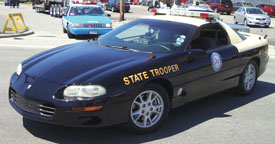 1991-2002 Chevrolet
1991-2002 Chevrolet
Camaro B4C
Though never as popular as the Ford Mustang SSP, Chevrolet’s Camaro B4C has long held the distinction of being the fastest purpose-built police car. In Michigan State Police testing, a 2002 version of the Camaro B4C achieved the astonishing top speed of 159 mph.
The first B4C models were based on the third generation Camaro and used heavy-duty parts from the high-performance Z28 model, including its 205-horsepower, 5.0-liter and 245-horspeower, 5.7-liter V8 engines in the non-descript bodies of the Camaro RS. When the new fourth-generation Camaro was introduced for 1993, the B4C continued with a revised 275-horspower, 5.7-liter V8 under its hood. Finally in 1998, the new “LS-1” series 5.7-liter V8 became part of the 305-horsepower B4C.
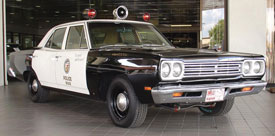 1968-1970 Plymouth
1968-1970 Plymouth
Belvedere Pursuit
In 1968, Plymouth redesigned its mid-size cars and produced one of the cleanest designs of the era. The police car version of the Belvedere sedan was a straightforward prowler that won sales with a combination of excellent power from it 330-horsepower, 383-cubic inch V8 and low prices. For urban police forces it was an almost-perfect combination. “If you ask ‘Why Plymouth?’” shouted Plymouth’s 1968 police car brochure, “take a 20 mph corner in one. At 60.”
The Belvedere police package was agile and fast enough to attract the attention of muscle car enthusiasts. So also in 1968, Plymouth took the cop car’s mechanical bits and put them into a two-door shell to create the classic Road Runner.
This generation of Plymouth patrol car gained additional fame as an automotive star in “Adam-12,” which ran from 1968 to 1975.
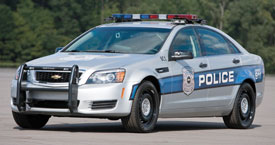 2012 Chevrolet
2012 Chevrolet
Caprice PPV
Though it’s early in this car’s life, the new Chevrolet Caprice Police Patrol Vehicle (PPV) is already developing a legend around it for its balanced and amazing performance.
Made in Australia by GM’s subsidiary Holden, the Caprice PPV is a longer wheelbase version of the same car that was sold to civilians as the 2008 and 2009 Pontiac G8. While the Caprice PPV is available with a V6 engine, it’s the version with the 6.0-liter V8 that’s attracting awe. Thanks to that 355-horsepower engine in Michigan State Police testing, the Caprice PPV stomped to 60 mph in 6.0-seconds and topped out at 154 mph. And it matched that speed with excellent handling and braking.
Whether or not the still-new Caprice PPV proves to be a classic remains to be seen. But with numbers like that, it’s already great.
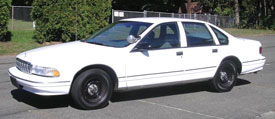 1994-1996 Chevrolet
1994-1996 Chevrolet
Caprice 9C1
When the Chevrolet Caprice was redesigned for the 2001 model year, it was derided as looking like a wallowing whale. In particular, when it was painted as a black-and-white police car, it was insulted as “Shamu.” But when that car received a new 260-horsepower, 5.7-liter “LT1” V8 for the 1994 model year, the Caprice 9C1 suddenly became one of the best all-around police vehicles of all time.
Built on a stout ladder frame with a trunk big enough to hold a barn dance, the Caprice 9C1 quickly earned a reputation for being incredibly tough and shockingly quick and handling exceptionally. In fact it was so well loved that as these Caprices were retired in the late 1990s and early 2000s, a small cottage industry developed to refurbish them and extend their service life.
But the highest compliment for this Caprice 9C1 came from Chevrolet itself. Redecorated with leather upholstery, black paint and 17-inch wheels, the 9C1 was sold to civilians as the high-performance 1994-1996 Impala SS.
Which one is your favorite? Be sure to vote in our poll! Click here.
Look for “10 Greatest Cop Cars” in the Spring 2013 issue of the Journal.





4 thoughts on “10 Greatest Cop Cars”
I got into civianian LE in 1975. The department I worked for then had 400 and 440 Dodge and Plymouth units. They were the fastest police cars I drove as the cars got slower and slower from that time on till I retired in 2004 with the Arizona Highway Patrol. Like most everybody else, I drove Crown Vics most of my career. I don’t understand why officers say they liked them. The V8 in them was an engine that stayed together, but had NO power. They got slower and slower over time and finally improved a little in the late 90’s, but still slow. Almost any Nissan or Toyota could outrun a Crown Vic. The new generation of officers are very lucky as they have these new Dodge Chargers with Hemi’s and the new Caprice with 355 HP to drive. Almost wants me to re-enlist!
The first police car I ever rode in was a 1971 Plymouth Satellite being inspected at a local garage when I was 7 or 8 years old.
The first car I drove was a 1981 Plymouth Volare’ with the 318ci. I went through the rest of the 80’s driving the Dodge Diplomats until 1986 with a slight detour to the Ford LTD II in 1984. The LTD II was without a doubt the fastest car that wouldn’t stop.
In 1987 we went to the 9C1 Caprices, which we drove until 1997 when the P71 Crown Victoria became the flavor. Admittedly the P71 Crown Vics got better as the evolved, but the 95-96 Caprices are hands down the best, but ugliest, car we drove.
I’m currently restoring an 72 LAPD AMC Matador Enforcer with the 401ci engine. After I put it through it’s paces on an EVOC course, I let you know if it’s better than the 9C1
What about the Dodge Coronet of the 70’s and the most popular of all time Ford Crown Victoria? The article presented many historic greats, but nothing for over 25 years compares to the Crown Vic.
I drove 1969 Polara’s-like the one in the photo.
When I got to South Los Angeles in Junhe ’71, we had the Polaras and the 70 Mercurys . the Calif. Highway Patrol was cheap, and to save money, they had left the Power Steering unit out–though the car was designed for power steering.
The Senior Officers held on to the Dodge Polaras
When I went out to Blythe, and I-10, we still had Polaras..
The Polara had a calibrated speedometer that went to 160 MPH, and you could get there very fast. Speed on I-10, from Blythe to 50 miles west was 90+ MPH .
The only drawbacks were that it had to be tuned up about every 20,000 miles, and you had to change the valve cover gaskets too. The exhaust manifold was right next to valve cover, and the gasket would harden and crack, allowing oil to drip onto the red hot (Literally) exhaust